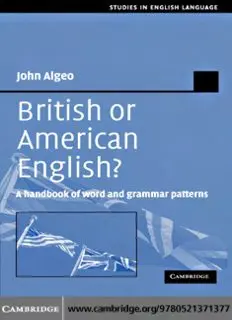
British or American English?: A Handbook of Word and Grammar Patterns PDF
Preview British or American English?: A Handbook of Word and Grammar Patterns
This page intentionally left blank British or American English? SpeakersofBritishandAmericanEnglishdisplaysomestrikingdifferences intheiruseofgrammar.Inthisdetailedsurvey,JohnAlgeoconsidersques- tionssuchas: ∗Wholivesonastreet,andwholivesinastreet? ∗Whotakesabath,andwhohasabath? ∗WhosaysNeitherdoI,andwhosaysNordoI? ∗After“thankyou”,whosaysNotatallandwhosaysYou’rewelcome? ∗Whoseteamareontheball,andwhoseteamis? Containingextensivequotationsfromreal-lifeEnglishonbothsidesofthe Atlantic, collected over the past twenty years, this is a clear and highly organizedguidetothedifferences–andthesimilarities–inthegrammarof BritishandAmericanspeakers.Writtenforthosewithnopriorknowledge oflinguistics,itshowshowthesegrammaticaldifferencesarelinkedmainly to particular words, and provides an accessible account of contemporary Englishasitisactuallyused. isProfessorEmeritusintheDepartmentofEnglish,Uni- versity of Georgia, Athens. His previous posts include Fulbright Senior Research Scholar, University College London (1986–7), Guggenheim Fellow (1986–7), and University of Georgia Alumni Foundation Distin- guishedProfessor(1988–94).Overthepastfortyyearshehascontributed paperstoawidevarietyofbooksandjournals,including91bookreviews. TheaimofthisseriesistoprovideaframeworkfororiginalstudiesofEnglish,both present-dayandpast.Allbooksarebasedsecurelyonempiricalresearch,andrepresent theoreticalanddescriptivecontributionstoourknowledgeofnationalvarietiesof English,bothwrittenandspoken.Theseriescoversabroadrangeoftopicsand approaches,includingsyntax,phonology,grammar,vocabulary,discourse,pragmatics andsociolinguistics,andisaimedataninternationalreadership. Generaleditor MerjaKyto¨(UppsalaUniversity) EditorialBoard BasAarts(UniversityCollegeLondon),JohnAlgeo(UniversityofGeorgia),Susan Fitzmaurice(NorthernArizonaUniversity),RichardHogg(UniversityofManchester), CharlesF.Meyer(UniversityofMassachusetts) Alreadypublishedinthisseries: ChristianMair InfinitivalComplementClausesinEnglish:aStudyofSyntaxinDiscourse CharlesF.Meyer AppositioninContemporaryEnglish JanFirbas FunctionalSentencePerspectiveinWrittenandSpokenCommunication IzchakM.Schlesinger CognitiveSpaceandLinguisticCase KatieWales PersonalPronounsinPresent-dayEnglish LauraWright TheDevelopmentofStandardEnglish,1300–1800:Theories,Descriptions,Conflicts CharlesF.Meyer EnglishCorpusLinguistics:TheoryandPractice StephenJ.NagleandSaraL.Sanders(eds.) EnglishintheSouthernUnitedStates AnneCurzan GenderShiftsintheHistoryofEnglish KingsleyBolton ChineseEnglishes IrmaTaavitsainenandPa¨iviPahta(eds.) MedicalandScientificWritinginLateMedievalEnglish ElizabethGordon,LyleCampbell,JenniferHay,MargaretMaclagan,AndreaSudbury andPeterTrudgill NewZealandEnglish:ItsOriginsandEvolution RaymondHickey(ed.) LegaciesofColonialEnglish MerjaKyto¨,MatsRyde´nandErikSmitterberg(eds.) NineteenthCenturyEnglish:StabilityandChange British or American English? A Handbook of Word and Grammar Patterns JOHN ALGEO UniversityofGeorgia Cambridge,NewYork,Melbourne,Madrid,CapeTown,Singapore,SãoPaulo Cambridge University Press TheEdinburghBuilding,Cambridge,UK PublishedintheUnitedStatesofAmericabyCambridgeUniversityPress,NewYork www.cambridge.org Information on this title: www.cambridg e.org /9780521371377 ©JohnAlgeo2006 Thispublicationisincopyright.Subjecttostatutoryexceptionandtotheprovisionof relevantcollectivelicensingagreements,noreproductionofanypartmaytakeplace withoutthewrittenpermissionofCambridgeUniversityPress. Firstpublishedinprintformat 2006 - ---- eBook(EBL) - --- eBook(EBL) - ---- hardback - --- hardback - ---- paperback - --- paperback CambridgeUniversityPresshasnoresponsibilityforthepersistenceoraccuracyofs forexternalorthird-partyinternetwebsitesreferredtointhispublication,anddoesnot guaranteethatanycontentonsuchwebsitesis,orwillremain,accurateorappropriate. Contents Preface page xi Acknowledgments xii Introduction 1 BritishandAmericanasnationalvarieties 1 DifferencesbetweenBritishandAmerican 2 Thebasisofthisstudy 2 Sourcesofcomparativestatisticsandcitations 4 Conventionsandorganizationofthisstudy 6 PartI PartsofSpeech 9 1 Verbs 11 1.1 Derivation 11 1.2 Form 12 1.3 Verbphrases 24 1.4 Functions 31 2 Determiners 43 2.1 Definitearticle 43 2.2 Indefinitearticle 49 2.3 Possessiveconstruction 52 2.4 Nodeterminerversussomedeterminer 53 2.5 Predeterminersandpostdeterminers 64 3 Nouns 69 3.1 Derivation 69 3.2 Form 76 3.3 Function 86 3.4 Namesandtitles 102 3.5 Genitiveconstructions 104 vii viii Contents 4 Pronouns 107 4.1 Personal 107 4.2 Impersonal 110 4.3 Demonstrative 111 4.4 Relative 112 4.5 Interrogative 114 4.6 Indefinite 114 4.7 Expletive 115 4.8 Case 116 5 Adjectives 119 5.1 Derivation 119 5.2 Frequencyandcollocation 126 5.3 Comparison 128 5.4 Adjectiveorder 131 6 Adverbs 133 6.1 General 133 6.2 Disjuncts 146 6.3 Comparison 148 6.4 Adverborder 148 6.5 Adverbialparticles 151 7 Qualifiers 153 7.1 Modifyingadjectivesoradverbs 153 7.2 Modifyingprepositionalphrases 157 7.3 Modifyingcomparativestructures 158 8 Prepositions 159 8.1 Choiceofpreposition 159 8.2 Omissionofanypreposition 194 8.3 Omissionoftheprepositionalobject 197 8.4 Prepositionalphraseversusnounadjunct 197 8.5 Orderofnumberswithby 197 9 Conjunctions 199 9.1 Coordinatingconjunctions 199 9.2 Subordinatingconjunctions 201 10 Interjections 207 PartII SyntacticConstructions 215 11 Complementation 217 11.1 Complementationofverbs 217 11.2 Complementationofnouns 251 11.3 Complementationofadjectives 257 11.4 Complementationofadverbs 261
